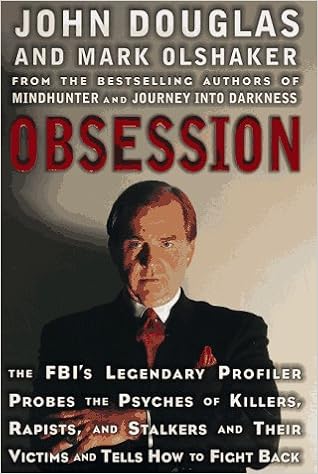
Obsession: The FBI's Legendary Profiler Probes the Psyches of Killers, Rapists and Stalkers and Their Victims and Tells How to Fight Back
Hardcover – February 9, 1998
Description
From Publishers Weekly With the warmth and frank bias of a firsthand observer, Douglas, the founder and head of the FBI's Investigative Support Unit and the inspiration for the character of Jack Crawford in Silence of the Lambs and Red Dragon, here describes violent crimes and their consequences. With co-author Olshaker, with whom he wrote Mindhunter and Journey into Darkness, Douglas details the crimes and case histories of serial killers, serial rapists, child molesters, stalkers and others. Included are infamous killers such as Edward Gein, Ted Bundy and Robert Chambers, along with less publicized, though just as disturbing, purveyors of acts of fatal obsession. Asserting "that behavior reflects personality," Douglas shows how he and his colleagues can assess the different temperaments and motivations at work behind grisly acts. Rapists tend to fall into four basic categories, for example, the "power-reassurance rapist" (driven by feelings of inadequacy), the "exploitive" rapist (impulsive and overtly macho), the "anger" rapist (who uses sex to displace his rage) and, cruelest of all, the "sadistic" rapist, who "simply gets off on hurting people." What stands out in this eye-opening book is how Douglas's compassion for the survivors of violent crimes seems to equal his understanding of the criminals themselves. His description of the work of the countless people who counsel, comfort and fight for the rights of victims serves as a welcome reminder that horrific and isolated acts of darkness and coldness are counterbalanced by a warmhearted and, one hopes, more natural human determination to help. Copyright 1998 Reed Business Information, Inc. From Library Journal Following on the heels of Douglas's Mindhunter (LJ 11/15/95) and both authors' Journey into Darkness (Scribner, 1997), which were best sellers, this book focuses on crimes against women. The title refers both to criminal motivation?the authors have little faith in the possibility of rehabilitation?and to Douglas's commitment as a victims' rights advocate. Founder and until recently head of the FBI's Investigative Support Unit, he "plead[s] guilty" to being "overly emotional" on the need for stringent prison sentences and terms of parole. In his discussion of self-protection, Douglas cites Gavin de Becker, whose The Gift of Fear (LJ 6/15/97) is a more complete guide to that subject. Although there is less emphasis on criminal profiling and some overlap with prior material, this work is generally insightful and certainly heartfelt about the devastating effects of violence on its victims and those who love them. Of interest to readers of the previous books. -?Gregor A. Preston, formerly with Univ. of California Lib., Davis Copyright 1998 Reed Business Information, Inc. From Booklist Fans of the reprehensible will cheer this weighty examination of the psychological profiling of criminals. Douglas and Olshaker's subjects this time (their previous true-crime tomes include Journey into Darkness [1997]) are the mind, methodology, and, well, obsession of the sexual predator. Douglas headed the FBI's Investigative Support Unit and draws upon that experience in this endeavor. Helpfully and authoritatively, he and professional writer Olshaker advise how to avoid being victimized by the vicious miscreants they describe, but mostly the book is intended to give true-crime fans a thrill. Its style is terse, not to say Joe Fridayesque; the stories move right along, spewing detail and salient observation. Douglas and Olshaker cover an incredibly wide range of cases, some only fleetingly, so an index enhancing reference value is welcome. Tastefully gory, with a soupcon of twisted sexual content and, considering its very rough subject, a minimum of rough language, Obsession is a treat for those who enjoy trying to make sense of the world of senseless violence. Mike Tribby From Kirkus Reviews A look at rape-and-murder and its perpetrators by one of the men who invented the forensic art of psychological profiling. Douglas (Mindhunter, also with Olshaker, not reviewed, etc.) was the founder and longtime head of the FBI's Investigative Support Unit and over his career saw many cases that went unsolved, including the Green River Killer, a case so frustrating that it nearly killed Douglas himself. Douglas's readers will be familiar with this assortment of famously grisly scenes combined with profiles of the murderers. This book focuses mainly on stalkers and their victims, so Douglas necessarily revisits the scenes of Rebecca Schaffer, Dominique Dunne, and Teresa Saldana. He also gives an overview of rapists/murderers such as Ted Bundy and Gary Heidnik, the City of Brotherly Love's answer to Jeffrey Dahmer. Unfortunately, much of the information here is already so familiar to crime buffs that there isn't much to be gleaned from these sections. Douglas is much better at the beginning, when he discusses a little-known killer who seems to have been the basis for Francis Dolarhyde in Red Dragon (Thomas Harris fans, take note). Douglas's profile of this stalker and killer is illuminating, unlike too much of this book, which is merely titillating. The promise of the subtitle goes unfulfilled--the ``fighting back'' seems limited to victim's families joining support groups, rather than any real advice to those seeking protection from a stalker. In fact, most of these victims had restraining orders against their stalkers, which were of little use in the face of a knife or a gun. Not much more than a collection of truly horrifying stories, which is a shame for both the reader, who justifiably expects more, and for Douglas, who has more to offer. (Author tour) -- Copyright ©1998, Kirkus Associates, LP. All rights reserved. Read more
Features & Highlights
- The best-selling authors of Mindhunter combine profiles of numerous well-know cases with practical advice on how to protect oneself and loved ones against violence in a study of the violent, interpersonal crimes committed against women and the elderly. 175,000 first printing. Tour.





